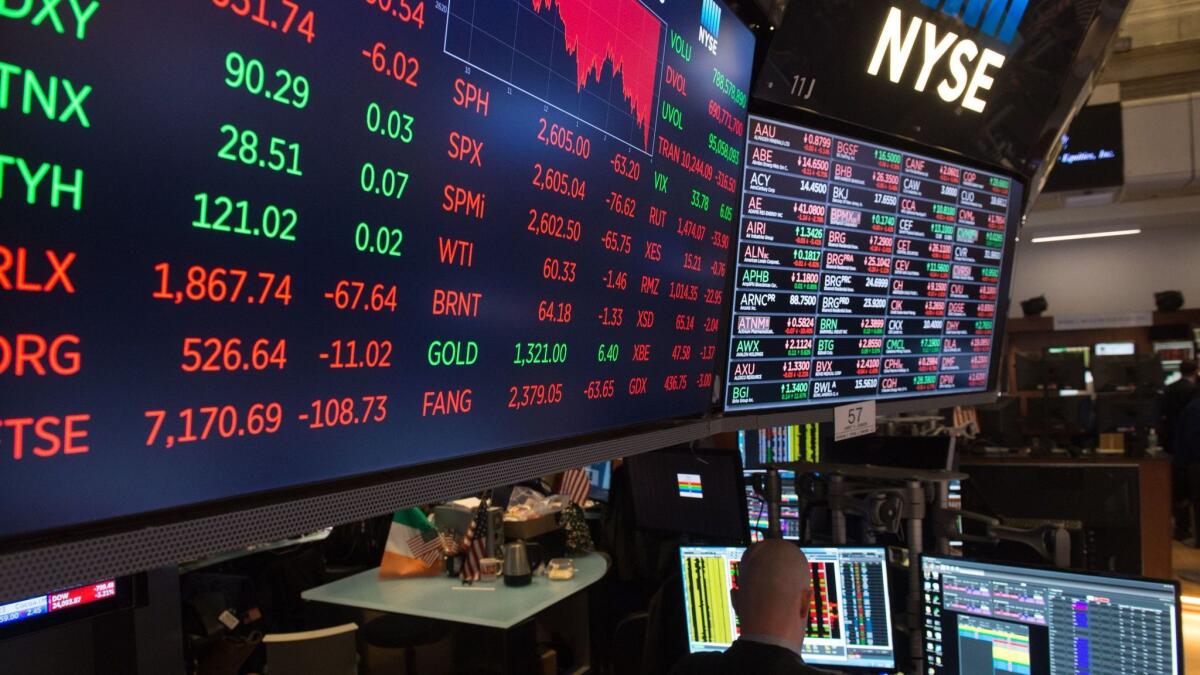Stock market correction: What it is and why it’s not necessarily bad

- Share via
Reporting from Washington — The stock market is all about numbers, and the biggest one to remember in the wake of this month’s steep losses is 10.
When a stock index declines 10% or more from its recent high, that’s considered a market correction.
After plunging more than 1,000 points on Thursday for the second time this week, the Dow Jones industrial average dropped into a correction. So did the broader Standard & Poor’s 500 index. Both were down a little over 10% from the record high reached Jan. 26 before Friday’s gains pulled them both out of correction. The Dow is down 9.1%, and the S&P 500 was off 8.8% from last month’s highs after Friday’s market close.
The technology-heavy Nasdaq composite was near correction territory, off 9.7% from its Jan. 26 high through Thursday. After Friday’s increase, the Nasdaq was down 8.4%.
But another steep decline on Monday could push all three indexes back into correction.
Corrections historically occur as frequently as congressional elections — about once every two years — although they usually take place over weeks, not a few days.
Analysts said they are necessary course adjustments that keep stock prices on a broader upward trajectory. A correction is healthy, unless it leads to a deeper downturn.
Since 1928, the S&P 500 has averaged a correction about once every two years. There have been 16 corrections in the S&P 500 since the beginning of 1980, according to data from Yardeni Research Inc.
A much steeper decline of 20% or more is considered a bear market — the animal counterpoint to a rising, or bull, market. Four of those corrections since the start of 1980 grew into bear markets.
The most recent bear market began in October 2007 and lasted until March 2009, with the S&P 500 plummeting 57% amid the chaos of the Great Recession and financial crisis.
Analysts say corrections are important cyclical events in preventing stock prices from getting so out of whack that they lead to a more severe bear market.
Since the recent bull market began in early 2009, there had been four S&P 500 corrections before this year. The declines ranged from 12% to 19%, and all amounted to nothing more than speed bumps in the markets’ continued ascent. The longest those corrections lasted was 157 days.
Throughout the recovery from the Great Recession, interest rates and inflation have remained extremely low, which made stocks a more attractive investment than bonds.
In December, former Federal Reserve Chairwoman Janet L. Yellen said that she and her colleagues on the central bank monetary policymaking board believed stock valuations were “elevated” compared to historical metrics, though not “necessarily overvalued.”
But economic growth has been picking up, wages have started rising more rapidly and the Republican tax cuts promise to provide more stimulus this year. That has led to concerns that inflation will start accelerating.
The additional federal borrowing needed to offset the loss of tax revenue and increased spending have pushed up interest rates on bonds and could lead the Fed to hike its benchmark rate more quickly. The additional borrowing creates more supply in the bond market, forcing the Treasury to increase the yield to lure buyers. That was evident Thursday, when demand was so weak at an auction of 30-year Treasury bonds that the yield had to be pushed up to an 11-month high.
Stock values had been based on low interest rates and low inflation, said Michael Arone, chief investment strategist at State Street Global Advisors, an investment management firm. Now those valuations need to be reset, he said.
“The market began to revalue stock prices, and that resulted in a pickup in volatility,” he said.
Analysts and U.S. officials have said the fundamentals of the economy remain stable, so the market correction shouldn’t turn into a bear market.
“I’m not overly concerned about the market volatility,” Treasury Secretary Steven T. Mnuchin told a House committee on Tuesday. “The fundamentals are quite strong.”
Jack Ablin, chief investment officer at Cresset Wealth Advisors, an investment advisory firm, said there are three types of market downturns: technical, cyclical and systemic.
Technical pullbacks are the most benign, he said in a research note this week.
“When equity valuations get out of line with fundamentals, like earnings and dividends, prices correct accordingly,” he said. “Technical pullbacks, while disturbing, are generally short-lived with the bottoming process occurring over a period of days or weeks.”
Cyclical downturns are more likely to lead to bear markets because credit conditions also begin to tighten, he said, pointing to the example of the bursting of the dot-com bubble of early internet investment in 2000. That bear market caused the S&P 500 to lose nearly half its value before its pullback ended 2 1/2 years later. It took more than seven years for the S&P 500 to top the record high it hit in 2000. The Nasdaq, which was even harder hit because of its concentration of technology stocks, didn’t reach its dot-com-era high until 2015.
Systemic downturns are the most severe because they “represent a general loss of confidence in a country’s financial or political system” and spread like a contagion. The 2008 financial crisis was an example of such a “once-in-a-generation” event, Ablin said.
He believes this latest pullback is a technical correction because credit conditions have not tightened.
Twitter: @JimPuzzanghera
UPDATES:
1:40 p.m.: This article was updated with Friday’s market closing figures.
11:15 a.m.: This article was updated to reflect new market figures.
11 a.m.: This article was updated with additional details about the recent market declines.
This article originally was published at 10:25 a.m.
More to Read
Inside the business of entertainment
The Wide Shot brings you news, analysis and insights on everything from streaming wars to production — and what it all means for the future.
You may occasionally receive promotional content from the Los Angeles Times.











